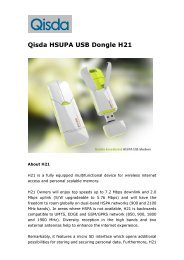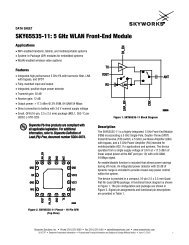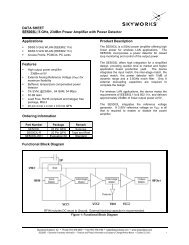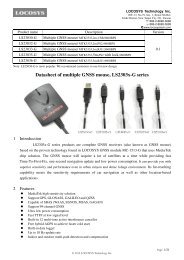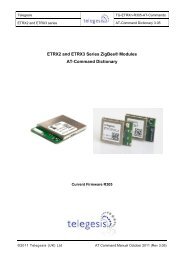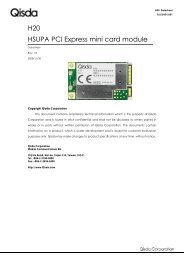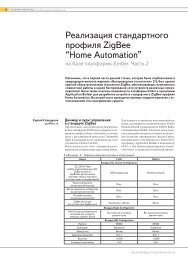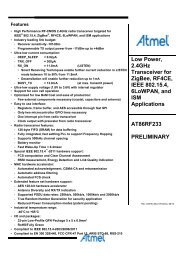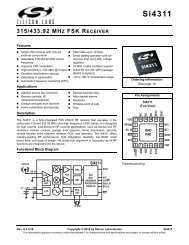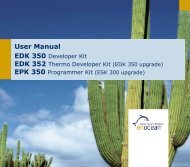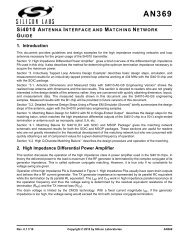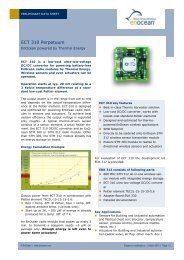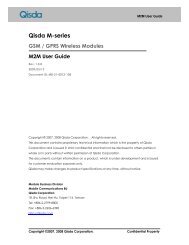Bluetooth Commands - wless.ru
Bluetooth Commands - wless.ru
Bluetooth Commands - wless.ru
You also want an ePaper? Increase the reach of your titles
YUMPU automatically turns print PDFs into web optimized ePapers that Google loves.
Chapter 2 – AT <strong>Commands</strong><br />
About Command/Data Mode<br />
1. Fast Data Mode<br />
Fast data mode is currently supported in point to point mode only. There is no such feature in the ATMP<br />
Multi-Point code implementation since the parser needs to be on.<br />
The drawback to this is that once in fast data mode there are limited ways to get out of it like CPU reset,<br />
power down, or strobing PIO(4) for >5ms. The advantage of this mode is that the data being sent does<br />
not have to be evaluated or processed for AT commands and will allow for a faster effective data<br />
throughput of around 250Kbps. To verify you are in fast data mode type +++ it will pass directly<br />
through the UART because the AT Command parser is off. Else the +++ will be accepted because<br />
the AT Command parser is still on and returns “OK”. On the previous 4Mbit legacy modules, the escape<br />
characters were fixed and set to “ATMC”; this is no longer implemented.<br />
2. Command/Data Mode<br />
The Command Mode or Data Mode will slow down the throughput when the radio looks for the AT<br />
commands. One way to allow minimal overhead transmission burden is to perform all configuration<br />
commands, and then place the radio into the fast data mode.<br />
About Byte Gaps and Data Latency<br />
The way <strong>Bluetooth</strong> is designed and operates random byte gaps of 5 msec to 20 ms are common. Packet size<br />
will vary from transmission to transmission. The faster the UART speed the smaller the byte gap delay.<br />
Effective data payload throughput in fast data mode is approximately 250Kbps and 35Kbps in regular data<br />
mode when the AT parser looks at each character for ASCII valid command scripts in the data stream. The<br />
radio RX has very limited buffering so if you do not use hardware flow control and are transmitting further<br />
distances you will quickly overflow the buffer because of RF retransmissions, etc.<br />
When a <strong>Bluetooth</strong> connection is made the radio modem goes into regular data mode per the power-up factory<br />
default settings. This enables the user to remotely configure the radio settings via a remote RF <strong>Bluetooth</strong><br />
connection. Basically you can setup the radio so no commands are required to be sent from the embedded<br />
side of the radios UART. This will prevent any software embedded firmware development or testing for<br />
legacy systems.<br />
Data Mode <strong>Commands</strong><br />
+++ Put Device into Command Mode<br />
This sequence is used to force the radio into command mode state. If the Radio has been placed in Fast<br />
Data Mode this command will have no affect and the typed command will be treated as data. When using<br />
this command allow at least 100ms delay before sending the next AT command.<br />
Format: +++<br />
Return Parameters: If successful an “OK” is returned, or nothing will be returned if already<br />
in command mode or fast data mode.<br />
EXAMPLE:<br />
TYPE:<br />
+++<br />
REPLY:<br />
OK<br />
Note: This command is only required if the module is RF CONNECTED, it has not effect if the<br />
module is not connected or if it is connected in Fast Data Mode.<br />
SESC Set Command Mode Escape Character<br />
This command sets the radio’s escape character, used to put the radio into command mode.<br />
Format:<br />
ATSESC,<br />
Parameter:<br />
ASCII Value: Integer value of a non extended ACII character<br />
Factory Default: 43 = “+”<br />
EXAMPLE:<br />
TYPE:<br />
ATSESC,43<br />
REPLY:<br />
OK<br />
OR<br />
ERROR<br />
Multi-Tech Systems, Inc. SocketWireless <strong>Bluetooth</strong> AT <strong>Commands</strong> (S000360G) 39



